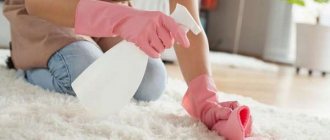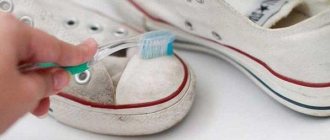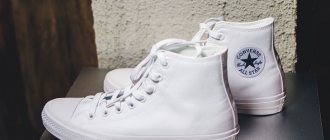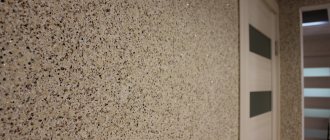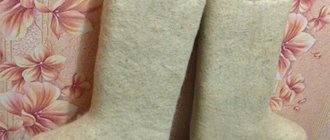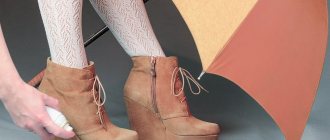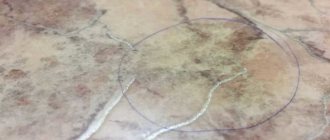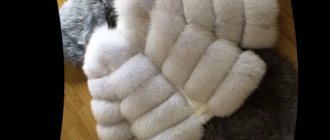How to care for rubber shoes
Caring for rubber shoes is easy. It does not require special storage, professional dry cleaning and the purchase of expensive care products, unlike other types of shoes.
However, in order for boots and shoes made of rubber to last a long time, proper care is still necessary. Need to:
- clean them immediately after contamination;
- dry thoroughly from the inside;
- protect from the negative effects of sunlight and reagents;
- impregnate with oil or wax compounds to prevent cracking.
Professional products
Manufacturers of household chemicals are not asleep and are actively offering their products designed specifically for white shoes.
The list of the most effective drugs includes:
- Collonil. It is more of a protective agent than a cleaning agent. This spray is sprayed over the entire surface of the boots, creating a barrier that protects the boots from dirt and moisture. It prevents the appearance of salt stains and “leaking” of shoes. The only drawback of such protection is the price of the product. For a 400 ml bottle you will have to pay about 1,500 rubles;
- Tarrago. This Spanish spray turns into foam once applied to shoes. The composition is effective, but works very carefully, so it is suitable for almost all materials: textiles, leather, velor, suede, nubuck. In addition to the spray, the Tarrago brand produces a whole line of various cleaning products for various types of shoes;
- Vanish. This universal stain remover is perfect for cleaning textile shoes. In principle, any bleach can be used. The main thing is that it is without chlorine, otherwise the duds may turn yellow. The absence of chlorine in the composition is indicated by the mark “Oxi”;
- Saphir. This spray, again, is more protective than cleansing. It was included in this rating due to the fact that it is suitable for shoes made of synthetic fabrics and membrane liners;
- Mystik. A universal cleaning paste that removes stains of various origins. The composition is suitable for various types of blowers, while coping with old and persistent stains.
If none of the products cope with the task, you can always dry-clean the duds. They use special equipment that is not commercially available. Therefore, the quality of professional cleaning is many times higher than that of household compounds sold in regular stores.
Care tips that increase the service life of rubber shoes
Rubber shoes are made from several materials. They are all waterproof, but have different characteristics. Conveniently, the rules of care are almost the same for everyone.
You can read more about the materials here.
Wash correctly
Contaminants are washed off with warm water and soap after each use. Then the surface is thoroughly wiped.
PVC shoes are durable and can be rubbed without fear; EVA shoes need to be handled more carefully - more soap suds, less effort.
Heavy with thin walls - made of PVC (99%. Perhaps rubber, but it is not used for making boots in modern production).
Light and soft, and the material is similar to frozen foam - made of EVA .
Drying correctly
Moisture from the outside is not absorbed into rubber shoes - this is a plus, but it also does not evaporate from the inside - this is a minus. The only way for water and steam to escape is through the top.
If your feet are sweaty or water gets inside, you need to dry your shoes thoroughly:
- remove the insole and insulating liner;
- put newspaper inside so that moisture is absorbed into it (change several times during the drying process);
- put the shoes in a warm, dry place.
EVA begins to melt at temperatures from 65°C, PVC - from 100°C, so be careful when drying near the battery.
We store it correctly
After making sure that the shoes are clean and dry, you can put them away for a long time in a cool place with low humidity.
Remember important points when organizing storage:
- It is better to store rubber shoes in boxes or a closed cabinet to protect them from fading;
- Paper and newspaper should be placed inside the shoes to wick away moisture;
- It is better to fold the insoles and removable insulation separately from the shoes;
Rubber shoes should be kept away from mothballs - they become rough and change color.
General rules of care
There are not many strict rules, but they are all relevant:
- study the label. Before using this or that product, you must carefully read the operating instructions for the boots. Branded shoes usually indicate the composition and give recommendations for care. It is advisable to comply with them;
- determine the nature of the contamination. There are different products developed for each type of stain. Using the “wrong” cleaning agent may give too weak a result or no effect at all;
- prepare the “tools”. Dirty brushes, sponges and rags are not suitable for light-colored boots. Such “inventory” will only aggravate the problem. Rags and washcloths of dark and bright colors should also not be used. Paints can react with chemical compounds and stain white duvets;
- to inspect. Even if the label of a cleaning product says that it is suitable for a given type of shoe, it is better to check. It is enough to apply a few drops of the selected composition to the surface of the boots and leave for 5–10 minutes. “Tests” are best carried out in inconspicuous areas, as shown in the photo below;
- remove “ordinary” contaminants. You should not start radical cleaning of hoods covered with dust and street dirt. Detergents will dissolve such deposits, and the shoes will become covered with gray stains.
At this point, preparation for cleaning can be considered completed, and then the process itself follows.
Self-removal of damage (stains, punctures)
I washed it and there is no stain
Impregnation for rubber shoes eliminates salt stains. Other types of dirt can be removed with a regular eraser or a cloth soaked in soapy water. By the way, you can also use an eraser to clean the light rubber soles of sneakers and sneakers.
Alcohol can deal with difficult stains. You cannot use acetone, gasoline or kerosene for cleaning - the material will be damaged.
Just need a little glue
The main “ingredient” for DIY repairs is glue. This can be hot melt glue, waterproof “Moment” or “liquid patch”. Before applying glue, you need to degrease the damaged area.
Small holes in EVA shoes can be closed without glue - just heat with a lighter and press.
Wear Nordman rubber shoes with pleasure and do not forget about proper care of them!
Source
How to properly care for rubber shoes
For rainy weather or autumn slush, it is difficult to find more practical and comfortable shoes than rubber, completely waterproof boots. Previously, you would only see such shoes on fishermen or children. Now beautiful, bright rubber shoes can be worn by absolutely any age and people of different social status.
The range of colors of rubber boots for spring and autumn is so diverse that everyone can choose something to suit their taste. These rubber shoes are very popular among young people. The original design and bright colors make rubber boots even fashionable. Bright colors will cheer you up in cloudy weather, and your feet will remain completely dry in the rain.
There is another huge advantage of such shoes - they are inexpensive and require minimal care. Why do rubber boots need any special treatment if they don’t get wet anyway? In fact, even rubber requires special care.
How to clean the inside?
During use, the dummies may develop an unpleasant odor. This problem can be solved. You can eliminate “orange” in several simple ways:
- alcohol-containing liquids. It is enough to wipe the inside of the boots with ammonia or ethyl alcohol and the “aroma” will go away. But you should not use a variety of colognes, even though they contain alcohol;
- green tea. The tea bags are placed inside the tea bags, or, if possible, under the insole. Then all you have to do is wait for the unpleasant smell to go away (the process may take several days);
- silica gel. This product quickly and efficiently absorbs not only excess moisture, but also foreign odors. To get the result, you need to put several bags of silica gel into each boot overnight;
- soda. 3-5 tablespoons of soda poured inside the puffers can also eliminate the problem in just a few hours. The main thing is to thoroughly shake out the shoes and wipe them from the inside;
- peroxide. It will not only remove the odor, but also help disinfect the surface. It is enough to moisten a cotton pad with peroxide and wipe the inside of the boots.
But it is worth remembering that an unpleasant odor usually appears due to various skin diseases (fungus, etc.), poor hygiene or improper care of shoes. If the root cause is not eliminated, the “aroma” will return again and again.
Why do rubber boots need impregnation?
You need to learn how to properly care for a pair of boots or galoshes made of colorful rubber. Such shoes require certain care rules, just like a pair made of a different material. But maintenance will be much easier and cheaper - special water-repellent agents and various impregnations, which are expensive, are not needed. A piece of cloth, water and a little sunflower oil or glycerin is all that is needed to care for rubber boots. This will ensure an attractive appearance of galoshes or boots for several seasons.
How to extend the life of rubber shoes
For boots to last a long time it is necessary:
- In order for the product to last as long as possible, when returning in damp weather, you need to wash them with lukewarm water and wipe dry.
- Durable rubber also allows oxygen to pass through, so it is very important to thoroughly dry the knitted covering inside the shoe.
- It is not advisable to wear rubber boots in dry and sunny weather, as heat can also cause the rubber to crack.
- To give the pair an attractive shine, it is necessary to lubricate the surface of the rubber with vegetable oil or glycerin from time to time. This impregnation will prevent the rubber from cracking.
- If the light-colored sole of rubber boots gets dirty, you can clean it with a regular eraser. An ordinary soft natural fabric soaked in a soap solution will also cope well with this task.
- Under no circumstances should you use kerosene or gasoline to clean rubber boots - these substances will ruin a pair of shoes.
- Wear rubber boots or galoshes only with socks made of natural thread. Rubber does not allow moisture to pass inside, but also does not allow the feet to breathe. For this reason, the insoles in rubber boots must be dried regularly.
How to remove stains from rubberized clothing
Rubberized products are relevant for several seasons, so it’s time to familiarize yourself with the information on removing stains from such clothing. It's no secret that it is not recommended to wash such a product in a washing machine, so you should carefully care for this kind of thing.
- A rubberized raincoat requires proper care. So, it is necessary to periodically clean the product from dust and dirt. It's easy to do:
- Use a brush to remove dust and dirt from the surface of the raincoat, or use a vacuum cleaner.
- The next step will be soaking; you will need to prepare warm water and add a little soda to it.
- Lay the raincoat on the table and brush it with a brush. You can use a soap solution with a generous amount of foam.
- After cleaning, you need to rinse the product and dry it in natural conditions.
- In addition to raincoats, you can find windbreakers and jackets made of rubberized fabric. To restore the purity of the product, you need to add 40 ml to the water. ammonia, treat all stains with the resulting solution.
- In order for the product to be immaculately clean, it is necessary to rinse it with a vinegar solution. Professionals recommend drying such items using hangers, and never iron them.
Drying
Dry rubber shoes in a well-ventilated area at room temperature.
You should not place your boots near a radiator or heating device. The material is also poorly affected by direct sunlight. Heating and then sudden cooling lead to cracking and brittleness of the material. This is especially true for products made from natural rubber.
The insole is dried separately on the radiator. This should be done every time you come home. The material does not allow moisture to pass through, but feet trapped in a sealed space sweat more intensely than in regular shoes. Wash the insole at least once every ten days.
Traditional methods
Folk remedies are considered weaker and gentler. This is both bad and good. On the one hand, they will not damage the bags, but on the other hand, such compositions will help remove only minor dirt. It will not be possible to wash boots from stubborn dirt or difficult stains.
Soda and lemon
Sprinkle baking soda on the contaminated area, and then pour a few drops of lemon juice on top. After the reaction (foam formation) is completed, the stain must be gently rubbed with a brush.
The remaining mixture is removed with a clean damp cloth. If necessary, the procedure is repeated.
Toothpaste
Important point: only white toothpaste is suitable for this method.
The stain on the dutik must be moistened with water. If heavily soiled, it is better to leave the boots to “soak” for 30–60 minutes. After which the paste is applied to the brush and “rubbed” into the contaminated area in a circular motion. The remaining mixture is removed with a damp sponge.
Yellow stains and dirt disappear quite slowly when using this method. For complete cleaning, up to five repetitions of all process steps may be required.
This method can be used to whiten not only the upper part of the boots, but also the sole or lower galosh (made of EVA).
Vinegar
To work, you will need a clean white cloth, water and regular table vinegar (transparent).
The process is quite simple:
- Vinegar is diluted with water in a ratio of 1 to 3.
- Moisten a cloth in the resulting mixture and rub the contaminated areas with it.
- Repeat step 2 until the desired result is achieved.
- Wash off the remaining vinegar with clean water.
This method is quite gentle, but effective. It is suitable for almost all types and areas of blowers. In addition to dirt, vinegar is good at removing unpleasant odors.
Starch and milk
Potato starch mixed with milk (1:1) also whitens shoes quite well. The resulting “gruel” must be applied in a thick layer to areas that have lost their original appearance. The composition must be left on the stains for a few minutes and then rubbed with a brush.
Remaining starch is removed with a damp cloth.
Acetone and vinegar
This mixture is quite aggressive, so it is not suitable for all types of dutik. But the effect of such cleaning is noticeable the first time.
It is necessary to work in a well-ventilated area, using personal protective equipment.
Mix acetone and vinegar in equal proportions. Use the resulting mixture to wipe off all dirt. Remove the remaining mixture with a damp sponge or cloth.
Laundry soap
Moisten a shoe brush generously with water and rub with laundry soap. Use this “tool” to treat all contaminated areas of the boots, then remove the remaining foam with clean water.
Peroxide and soda
To work, you will need to mix peroxide with soda and running water (1:2:1). As a result of these actions, you should get a thick paste that generously covers all contaminants. After 10 minutes, the stains should be rubbed with a brush, and then rinsed off with clean water.
You should not leave the mixture for a longer time, otherwise you will have to think about how to get rid of the yellowness on the dummies.
Removing stains
If after washing with soap there are gray spots on your boots, especially noticeable on white shoes near the soles, use an eraser.
Simply rub the eraser over the gray marks and rinse.
Coniferous tree resin, paint, fuel oil and other stains that cannot be washed off with water can be removed using:
- vegetable oil;
- alcohol;
- nail polish remover (without acetone).
Apply the product to a cotton pad and spot treat the stain. Wipe from the edges to the center.
Do not use kerosene, gasoline, acetone or other aggressive solvents on the material.
Simple cleansing between socks (in season).
First you need to get rid of the main dirt, especially if you kneaded it with your boots somewhere in an earthy place. Ideally, it is possible to wash them under the pressure of a stream from a hose in the yard.
If not, pour a deep basin or bucket of warm water and scrub with a sponge manually.
- ✦ It is better to immediately remove large pieces of stuck dirt with your hands and throw them in the trash so that they do not clog the drain.
- ✦ Try not to let water get inside or on the zipper if your boots have them.
- ✦ To avoid clogging the drain, pour dirty water into the toilet (if you wash at home), and not into the bathtub or sink.
- ✦ Change the water more often to avoid messy streaks.
- ✦ Carry out the procedure several times until the rubber is clean.
- ✦ Afterwards, wipe the boots with a soft, dry cloth and leave to dry.
This is a shortcut if you need to wash and wear again soon.
If you need to clean them completely (to put them away for long-term storage, for example), then continue.
Sometimes there just isn't enough water. Well then add some dishwashing liquid.
or other soapy liquid into the washing water or directly onto the sponge.
This is how they looked before washing.
Washed rubber boots with a sponge and soap
Sometimes it is recommended to use powder products like Pemolux, but remember that they can scratch your shoes.
Use the non-hard side of the sponge
as much , it will still be softer, but forget about very hard brushes and sponges.
Important! Do not use any types of oils, gasoline, kerosene, or other solvents for cleaning - they can harm your shoes, especially if you are not sure what type of rubber boots you have. Using vegetable oil, you can only clean rubber shoes made of rubber (not light-colored ones!), but this can greatly harm PVC.
Be sure to wash the insoles by hand or in the washing machine with vinegar.
, and dry them thoroughly so as not to detect an unpleasant musty smell later.
Repair
After long wear, the material becomes less elastic and therefore easily damaged.
If the boot allows water to pass through, but it is not clear in which place, lower the product into a basin of water. At the same time, close the top as much as possible so that no air escapes. The appearance of bubbles in the water will indicate the place where you should look for a puncture.
Once damage is found, find a suitable rubber patch. For example, buy rubber gloves that match the color of your boots or a swimming cap, cut up an old inflatable ring or rubber toy. The main thing is that the material fits smoothly to the boot.
For gluing, use rubber glue for shoes or inflatable boats.
- Clean the puncture site with sandpaper or wipe with alcohol.
- Degrease the patch with alcohol or nail polish remover.
- Apply glue to the patch and to the boot.
- Wait for it to dry, apply another layer of glue (follow the instructions on the tube).
- Press the patch onto the puncture and smooth it out from the middle to the edges.
- Leave to dry.
You can try to solder the leaky joint between the main part of the boot and the sole with a soldering iron. But you should act very carefully so as not to damage the material or make new holes.
How to remove stains from a rubber ball or children's toys
If you find ink stains on a ball or doll, then you should pay attention to the recommendations of experienced housewives.
- You can use an alcohol solution: not only lotion, but also perfume will do. Acetone, a nail polish remover, is no less effective. If you need to remove stains from a doll, then you should not use acetone, since along with the ink, the paint will also be removed from the face of the product. It is enough to treat the problem area with a napkin soaked in any specified product.
- If stains are found on toys made of soft rubber, then simply wipe the problem area with a cotton pad soaked in vegetable oil.
- Grandma's method is simple: use a mixture of bleach and vinegar. An equal proportion of each component guarantees one hundred percent results. After using this method, it is recommended to ventilate the room.
- If there are stains from a felt-tip pen on rubber toys, then it is enough to treat the problem area with any modern bleach.
- Stains from green paint may disappear if the product is placed in the open sun.
- If the contamination is minor, you can clean it with a nail file.
Storage
Storing rubber shoes.
Before sending for storage, follow these steps:
- Wash your boots and dry them well.
- Lubricate the surface with glycerin or other impregnation.
- Wrap the boots in paper and put them in a box.
- Store in a closet or other dry place.
Do not place rubber shoes near mothballs. This causes the material to become rougher and darker.
Take care of your shoes, wash them on time, wipe the material, and then your rubber boots will last a long time.
Source
How to treat shoes after purchase?
In order for your shoes to serve you faithfully for many years, you need to remember the MAIN rule
: Your wardrobe should have at least three pairs of shoes for each season. This can be explained very simply - in Russian climatic conditions, even the best pair of European shoes will quickly lose their appearance when worn every day. Shoes need a rest! But our task is to make your shoe life as long and comfortable as possible; for this it is important to follow some simple rules:
Immediately after purchase, any pair of shoes must be treated with special products that protect against dirt, dust, and water-repellent solutions. It is important to use only products suitable for the specific material from which the shoes are made. Let's consider primary care for each type of basic materials:
Colored or colorless cream that protects against dirt and dust; a product containing beeswax (creating a water-repellent coating); special cloth for polishing. If the sole of the shoe is made of leather, it must be treated with these compounds as well.
Preventing yellowing
Maintaining the white color of shoe soles can be achieved using preventive measures.
These include:
- regular care;
- timely cleaning immediately after contamination occurs;
- use of shoe cosmetics.
The whiteness of the edging will be preserved better if you apply a little colorless cream to it and polish the surface.
Treatment with water-repellent impregnation will also give a good effect. It can be applied after periodic cleaning and even before putting a pair on the street for the first time, when the item is still completely new.
Why do you need impregnation of rubber shoes?
You won't find more practical footwear than rubber boots in rainy and slushy weather. And if previously they could be seen mainly on fishermen and small children, now rubber shoes are worn at any age. Rubber shoes are also popular among young people. A cheerful range of colors and attractive design lift your spirits in any bad weather, and your feet are guaranteed to remain dry.
Another advantage of such products is minimal maintenance. It would seem, why do rubber shoes need impregnation if they don’t get wet anyway? However, both boots and rubber galoshes require some care.
Why do rubber shoes need impregnation?
Boots or galoshes made of rubber, like shoes made of other materials, must be properly cared for. But special water-repellent expensive products for impregnation and nutrition of the material are not needed - rubber shoes are unpretentious. Warm water, a piece of rag, a little vegetable oil or glycerin is all that is needed to ensure the good appearance of the shoes and their long-term use.
To make your boots last as long as possible:
- In damp, chilly weather, upon returning home, you need to wash your shoes with warm water and wipe them dry.
- The durable rubber upper does not allow air to pass through, so it is important to dry the inner knitted covering well. Shoes dry best in a well-ventilated area. But you can’t dry products near heat sources or in the sun - the material will crack and become rough. By the way, for the same reason it is undesirable to wear rubber boots in sunny weather.
- To give your shoes an attractive shine, you should periodically lubricate the upper with vegetable oil or glycerin. You can also use oil varnish with rubber glue or Vaseline for these purposes. This impregnation protects shoes from cracking.
- Light-colored soles can be easily cleaned with a regular eraser or a soft cloth dipped in soapy water. Kerosene or gasoline cannot be used for these purposes - they will damage the rubber top.
Recommendations
Expert advice will help you avoid many mistakes and carry out cleaning effectively:
- The most impressive shoes are those that combine a white sole with a contrasting upper. This point must be taken into account when using bleaching compounds, since carelessness during cleaning can ruin the appearance of your favorite pair.
- To gently clean the side of the white sole, it is convenient to use a toothbrush.
- Before you begin the bleaching process, you need to prepare a couple - wash off the dirt.
- It is recommended to carry out cleaning work with gloves to protect your hands.
